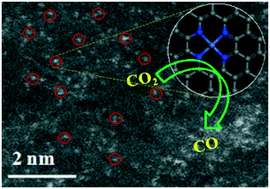Powerful CO2 electroreduction performance with N–carbon doped with single Ni atoms†
Abstract
The electrocatalytic carbon dioxide reduction reaction (CO2RR) under ambient conditions provides an intriguing strategy for the conversion of the greenhouse gas CO2 into valuable chemicals or fuels. However, CO2RR mainly relies on high-efficiency and low-cost catalysts, and enabling effective CO2 reduction on N-doped carbon (N–C) catalysts remains a huge challenge. Here, we reported a single dispersed Ni atoms doping strategy to boost the performance of N–C materials for CO2RR. The N–C nanosheets doped by a Ni single-atom catalyst (Ni–N–C) derived from a novel metal–organic complex precursor exhibited significantly enhanced performances for CO2 conversion in comparison with a pure N–C sample; furthermore, they presented high CO FE of ∼91.2% and 2.15-fold enhancement in current density at −0.9 V compared to N–C. Density functional theory (DFT) calculations combined with experimental results revealed that the single-atom dispersed Ni could alter the adsorption of intermediates onto the surface of the catalyst, further suppressing HER and boosting the CO2RR performance. The long-term stability tests demonstrated that the obtained Ni–N–C sample could be used for 22 h without obvious deactivation under ambient conditions. This work provides a guideline for rationally tuning the performance of cost-effective nanostructured N–C catalysts by this atomic scale metal-doping strategy.

- This article is part of the themed collection: 2019 Catalysis Science & Technology HOT Articles


 Please wait while we load your content...
Please wait while we load your content...